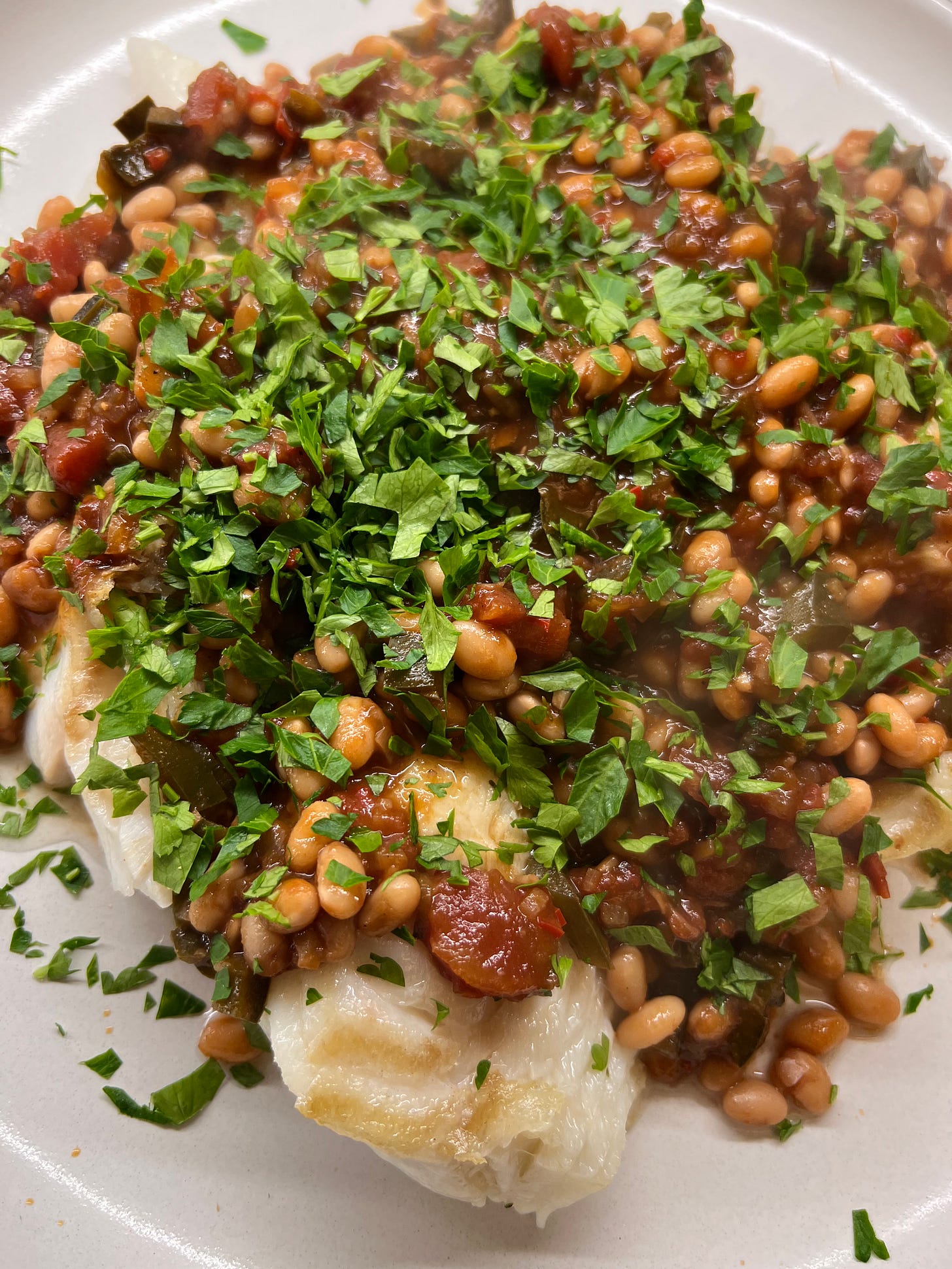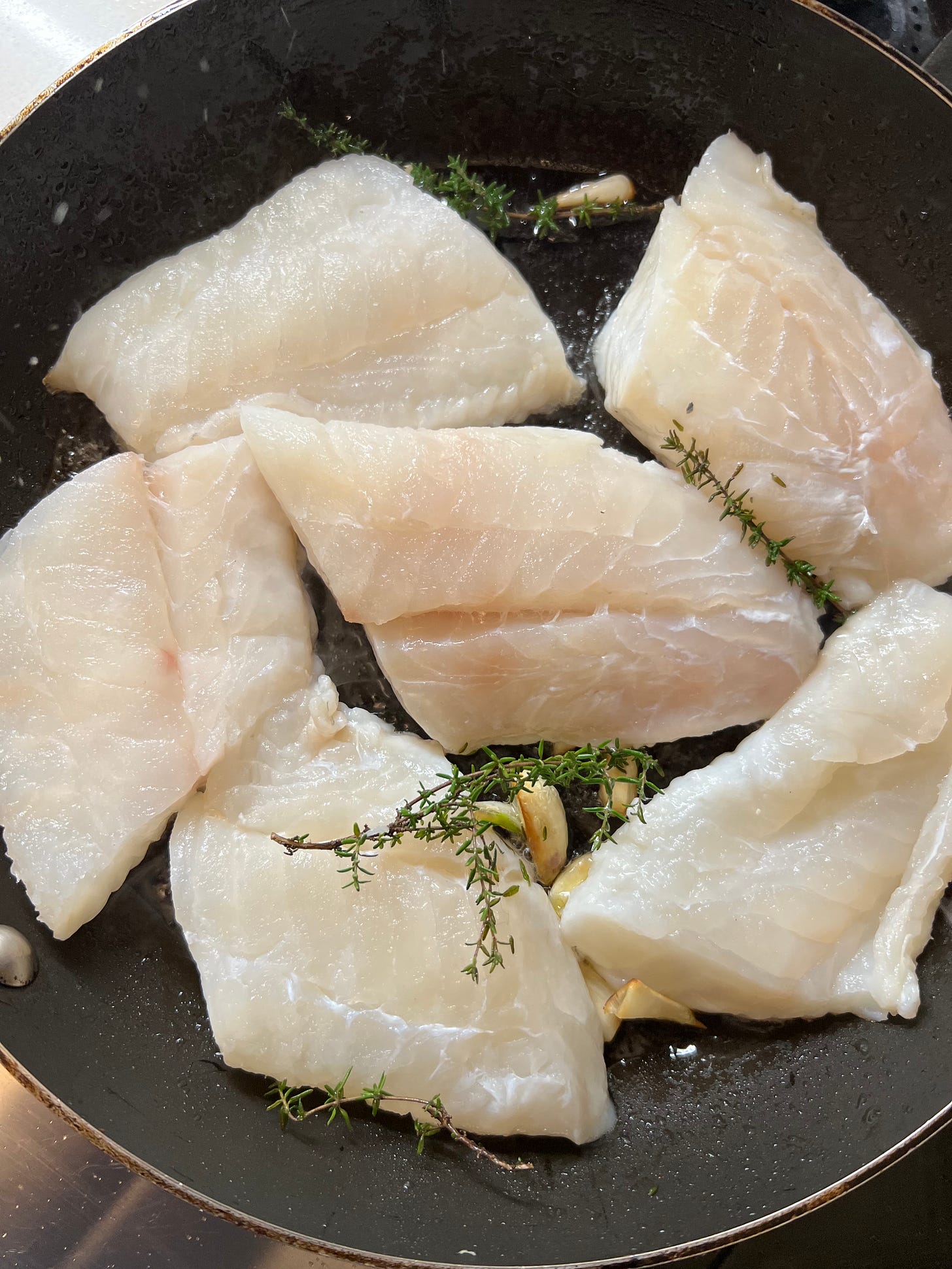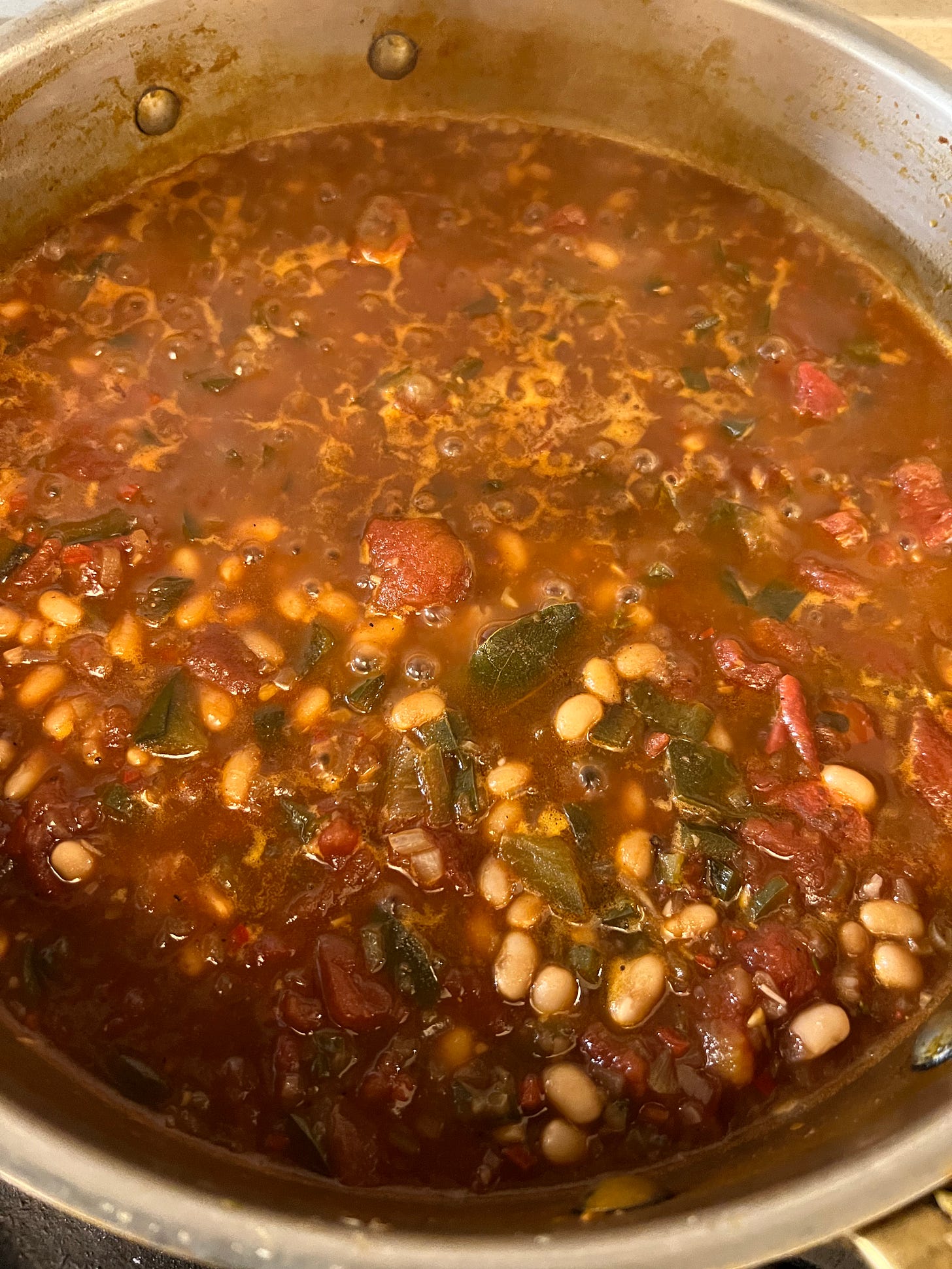Issue #39. Thanks to those of you who expressed interest in both som tam (Issue #37) and chicken pot pie (Issue #38), and to those of you who commented about how much you like the variety of recipes I include in this newsletter, which I will continue to do. Turns out both recipes were about equally popular. I’m wondering if the drop in views may indicate that things are opening up and people are spending less time at home in front of their computers (a good thing). I hope it doesn’t mean people are spending less time cooking (a bad thing).
I’ve been trying to cook more fish lately. The challenge isn’t the fish, which is easy to find around where we live—the Union Square Greenmarket and Eataly are my usual fishing holes—and quick to prepare. The challenge is my husband, who is not a seafood lover in general (an understatement), and who finds the idea of fish kind of icky. There are a few exceptions. If our friend Laurent Gras serves fish, Nate will eat it, whatever it is, with relish. (Inevitably, Nate will make the joke that Laurent should really think about opening a seafood restaurant, a nod to the days of his Michelin three-star L2O in Chicago.) With me, he is pickier. (I take no offense.) Thus, I’m always looking for the freshest, whitest, most unfishy fish I can find. I tend toward cod, or the occasional piece of black bass or flounder. As a result, I’m also always looking for different fish preparations to add interest to dinner.
Teach a Man to Fish
When I’m not fishing for cod at the Greenmarket, I take to the seas. Not really. But once, while Nate and I were visiting the magical Fogo Island off the easternmost coast of Newfoundland, we were fortunate to have been taken out on a private fishing boat. Although the centerpiece of the area’s economy for hundreds of years, commercial cod fishing is no longer legal in Newfoundland’s waters because of depleted stocks from overfishing. Recreational cod fishing is allowed during a very limited season and with strict quotas. In a matter of minutes, with just a simple line, we caught our limit. The fish practically jumped into the boat. The cod were so east to catch you could imagine how they could be overfished. Although Nate doesn’t love eating fish, he did have fun on the fishing boat, as you can see below.
The other day, we had a pescatarian friend over and I wanted to do something different with my cod. For some reason the idea of cod basquaise popped into my mind, even though I wasn’t totally sure what it was. I knew there was a spicy tomato component. I assumed there were olives. To devise my own recipe, I did what I usually do, and took a quick scan of recipes online, paying close attention to those proposed by Eric Ripert and Daniel Boulud, who know a thing or two about cooking fish. I cooked the dish with what I had on hand. The most untraditional thing I did was to throw in some freshly cooked navy beans I had in the fridge. The resulting cod à la basquaise trompée was quick and easy and very satisfying. Cooking is an evolution.
One trick with cod, which I suspect Laurent taught me, is to lightly salt the fish an hour or more before you intend to cook it. As the salt penetrates the flesh, it firms up a little and develops more flavor. To add further texture and flavor to the finished basquaise, I seared the cod before putting it into the sauce, as both Ripert and Boulud suggested. Ripert recommended spooning the sauce onto the plate and placing the fish on top to serve, but that seemed too much of a Le Bernardin approach to me. I recalled his army of waiters standing by with little pitchers of sauce to finish every plate at the table. Instead, I added the fish to the pan for a final bath and served the whole thing togther as one.
RECIPE: Cod Basquaise
(Serves 4 to 6)
1 ½ pounds cod fillets, cut into 6-ounce pieces
Sea salt
3 tablespoons extra-virgin olive oil
½ medium onion, finely diced
3 large cloves garlic, 1 minced and 2 split in half
1 or 2 slices jamon serrano, jamon de bayonne, prosciutto, chorizo, or other cured meat, finely diced (optional, but recommended)
1 bell pepper, red, yellow, green, or a combination, or 1 poblano, seeded and diced
1 large ripe tomato, to make 1 cup diced, or 1 cup chopped canned tomato
1 teaspoon double-concentrated tomato paste
½ cup dry red or white wine
Fresh or dried thyme or marjoram, plus more for cooking the fish
½ cup cooked beans (optional)
Generous pinch piment d’espelette, Aleppo pepper, cayenne, or other mild, flavorful ground chili
Freshly ground black pepper
Handful chopped parsley
Run your hand over the surface of the cod to find and remove any pin bones, tugging at them in the direction of the flakes so you do not ruin the integrity of the fillet. A tweezer helps. Place the cod on a plate or tray and lightly salt both sides of each fillet. Cover and set in the fridge for an hour or two.
Heat 1 1/2 tablespoons of the olive oil in a large saucepan over medium-high heat. Add the onion and cook 3 or 4 minutes until translucent. Add the garlic and cook another minute or two. Add the ham and bell pepper and cook until the pepper softens, another 4 or 5 minutes. Add the tomato and tomato paste, and continue cooking until the tomato gives off its liquid. Add the wine and bring to a simmer. Add a pinch of thyme leaves and/or marjoram and continue cooking a minute or two until the sauce comes together. If you need more liquid to maintain a saucy consistency, add more wine or water. Add the beans, if using, and the piment d’espelette, and adjust the seasoning with additional salt and freshly ground pepper. Keep simmering over the lowest heat.
Meanwhile, heat the remaining 1 1/2 tablespoons of olive oil in a large nonstick pan over medium-high heat. Add the 2 split garlic cloves and a few sprigs of fresh thyme, if you have. Remove the cod from the fridge and pat dry with paper towel. Place the fish skin-side up into the hot pan to sear. Don’t move the fish until you can see visible signs of browning. The fillets are delicate and should only be flipped once. Flip and cook the second side. When the flesh is opaque and the large flakes being to pull apart, carefully lift the fish and place it in the simmering sauce. Increase the heat to medium and cook another couple of minutes.
Carefully transfer the fish to individual serving plates or a platter and spoon the sauce on top. Sprinkle with parsley and serve.







Do you cook the fish straight from the fridge or do you let it come to room temp. first?
Thanks
Loved the article and the delightful photo of Nate holding the fish. The dish looks delicious.